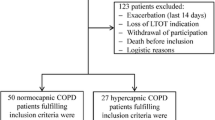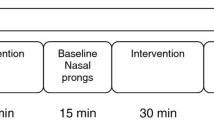Abstract
Aim
We aimed to investigate whether there is a difference in the rate of decrease in carboxyhemoglobin (COHB) values between high-flow nasal oxygen (HFNO) and normobaric oxygen (NBO) therapy.
Material and method
This retrospective observational study included patients with carbon monoxide poisoning who were treated with HFNO or NBO (control group). All patients were started on NBO therapy with a non-rebreather face mask at a rate of 15 L/min. In the NBO group, NBO treatment was continued until the COHB value fell below 10%. In the HFNO group, as soon as the preparation of the HFNO device was completed, NBO treatment was terminated and HFNO treatment was started and continued until the COHB value fell below 10%. The primary outcome of the study was the difference between HFNO and NBO in terms of COHB half-life rates.
Results
A total of 81 patients were included in the study, 44 in the HFNO group and 37 in the NBO group. The median of COHB t1/2 values between HFNO and the NBO treatment groups were 47.3 (IQR: 25–75%: 31.5–65.4) and 46 (IQR: 25–75%: 32.3–56.2), respectively, but this difference was not statistically significant (p = 0.81).
Conclusion
The results of this study suggest that HFNO treatment does not have a significant advantage over NBO treatment in the carbon monoxide elimination rate within the first 60 min of treatment.
Zusammenfassung
Ziel
Ziel der vorliegenden Studie war es zu untersuchen, ob ein Unterschied der Abnahmerate von Werten für Carboxyhämoglobin (COHB) zwischen nasaler High-Flow- (HFNO) und normobarer Sauerstofftherapie (NBO) besteht.
Material und Methoden
In diese retrospektive Beobachtungsstudie wurden Patienten mit Kohlenmonoxidvergiftung eingeschlossen, die mit HFNO oder NBO (Kontrollgruppe) behandelt wurden. Alle Patienten begannen mit NBO-Therapie mit einer Nichtrückatmungsmaske bei einer Rate von 15 l/min. In der NBO-Gruppe wurde NBO-Therapie fortgeführt, bis der COHB-Wert unter 10% fiel. In der HFNO-Gruppe wurde die NBO-Therapie beendet, sobald die Vorbereitung des HFNO-Geräts abgeschlossen war, und mit der HFNO-Therapie begonnen, diese wurde fortgesetzt, bis der COHB-Wert unter 10% fiel. Der primäre Endpunkt der Studie bestand aus dem Unterschied zwischen HFNO und NBO in Bezug auf die Halbwertszeiten für COHB.
Ergebnisse
In die Studie wurden 81 Patienten eingeschlossen, 44 in der HFNO-Gruppe und 37 in der NBO-Gruppe. Der Mittelwert der Werte für COHB t1/2 betrug im Vergleich zwischen HFNO- und NBO-Therapie 47,3 (Interquartilsabstand, IQR, 25–75%: 31,5–65,4) bzw. 46 (IQR 25–75%: 32,3–56,2), aber dieser Unterschied war nicht statistisch signifikant (p = 0,81).
Schlussfolgerung
Den Ergebnissen der vorliegenden Studie zufolge weist die HFNO-Therapie keinen signifikanten Vorteil gegenüber der NBO-Therapie hinsichtlich der Kohlenmonoxideliminationsrate innerhalb der ersten 60 min der Behandlung auf.


Similar content being viewed by others
References
Rose JJ, Wang L, Xu Q et al (2017) Carbon monoxide poisoning: pathogenesis, management, and future directions of therapy. Am J Respir Crit Care Med 195:596–606
Roth D, Schreiber W, Herkner H, Havel C (2014) Prevalence of carbon monoxide poisoning in patients presenting to a large emergency department. Int J Clin Pract 68:1239–1245
Kim YM, Shin HJ, Choi DW et al (2020) Comparison of high-flow nasal cannula oxygen therapy and conventional reserve-bag oxygen therapy in carbon monoxide intoxication: A pilot study. Am J Emerg Med 38(8):1621–1626. https://doi.org/10.1016/j.ajem.2019.158451
Gedikli U, Emektar E, Corbacioglu SK et al (2019) Determination of netrin‑1 levels and its relationship with neurotoxicity in carbon monoxide poisoning. Hum Exp Toxicol 38(5):561–566. https://doi.org/10.1177/0960327119828124
Roderique JD, Josef CS, Feldman MJ, Spiess BD (2015) A modern literature review of carbon monoxide poisoning theories, therapies, and potential targets for therapy advancement. Toxicology 334:45–58
Dagar S, Emektar E, Uzunosmanoglu H et al (2019) Clinical uses of lactate and lactate clearance in carbon monoxide poisoning. Istanbul Med J 20(6):519-23. https://doi.org/10.4274/imj.galenos.2019.10170
Kao LW, Nañagas KA (2004) Carbon monoxide poisoning. Emerg Med Clin North Am 22:985–1018
Weaver LK, Howe S, Hopkins R et al (2000) Carboxyhemoglobin half-life in carbon monoxide-poisoned patients treated with 100 % oxygen at atmospheric pressure. Chest 117:801–808
Pace N, Strajman E, Walker EL (1950) Acceleration of carbon monoxide elimination in man by high pressure oxygen. Science 111:652–654
Wolf SJ, Maloney GE, Shih RD et al (2017) Clinical policy: critical issues in the evaluation and management of adult patients presenting to the emergency department with acute carbon monoxide poisoning. Ann Emerg Med 69:98–107.e6
Weaver LK, Deru K (2017) Carboxyhemoglobin half-life during hyperbaric oxygen in a patient with lung dysfunction: a case report. Undersea Hyperb Med 44:173–177
Turgut K, Yavuz E (2020) Comparison of non-invasive CPAP with mask use in carbon monoxide poisoning. Am J Emerg Med 38(7):1454–1457. https://doi.org/10.1016/j.ajem.2020.04.050
Nishimura M (2016) High-flow nasal cannula oxygen therapy in adults: physiological benefits, indication, clinical benefits, and adverse effects. Respir Care 61(4):529–541
Gulen M, Satar S, Yesiloglu O, Avci A, Acehan S (2020) High-flow nasal cannula oxygen therapy in the management of acute respiratory distress syndrome secondary to opioid overdose. Turk J Emerg Med 21(1):30–33
Yesiloglu O, Gulen M, Satar S, Avci A, Acehan S, Akoglu H (2021) Treatment of carbon monoxide poisoning: high-flow nasal cannula versus non-rebreather face mask. Clin Toxicol 59(5):386–391
Tomruk O, Karaman K, Erdur B et al (2019) A new promising treatment strategy for carbon monoxide poisoning: high flow nasal cannula oxygen therapy. Med Sci Monit 25:605–609
Ozturan IU, Yaka E, Suner S et al (2019) Determination of carboxyhemoglobin half-life in patients with carbon monoxide toxicity treated with high flow nasal cannula oxygen therapy. Clin Toxicol 57(7):617–623. https://doi.org/10.1080/15563650.2018.1540046
Author information
Authors and Affiliations
Contributions
All authors: Conceived and designed the experiments, performed the experiments, analyzed and interpreted the data, contributed reagents, materials, analysis tools or data, wrote the paper.
Corresponding author
Ethics declarations
Conflict of interest
S. Akkan and Ö. Uyanik declare that they have no competing interests.
All procedures performed in studies involving human participants or on human tissue were in accordance with the local ethical committee and ethic committee of Turkish Medicines and Medical Devices Agency (Kahramanmaras Sutcu Imam University, local ethical committee) and with the 1975 Helsinki declaration and its later amendments or comparable ethical standards. Informed consent was obtained from all individual participants included in the study.
Additional information
Redaktion
Michael Buerke, Siegen
Availability of data
The SPSS files can be made available.

Scan QR code & read article online
Rights and permissions
About this article
Cite this article
Akkan, S., Uyanik, Ö. Comparing high-flow nasal oxygen therapy and normobaric oxygen therapy on the treatment of carbon monoxide poisoning. Med Klin Intensivmed Notfmed 119, 214–219 (2024). https://doi.org/10.1007/s00063-023-01044-5
Received:
Revised:
Accepted:
Published:
Issue Date:
DOI: https://doi.org/10.1007/s00063-023-01044-5
Keywords
- High-flow nasal oxygen therapy
- Illuminating gas poisonings
- Oxygen inhalation therapies
- Carboxyhemoglobin
- COHB




